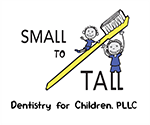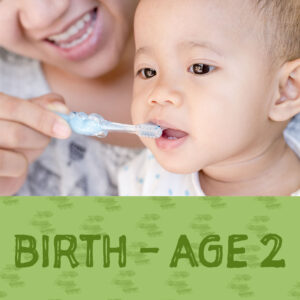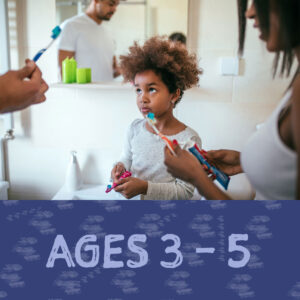Ages 3 – 5
Brush your child’s teeth twice a day – morning and night. Use a small smear of fluoride toothpaste on a child-size toothbrush.
Your child might want to start to clean their own teeth. Letting them hold the toothbrush with you will help them feel they are part of the action. YOU need to clean your child’s teeth until they are about 7 years old, as they do not have the dexterity to do a thorough job until then.
You should floss any teeth that touch each other to remove the food and plaque that collects between the teeth, daily.
Encourage your child to drink water after eating. This helps to wash away any leftover food.
Many young children enjoy brushing their teeth, and we encourage you to teach your child this healthy habit from an early age. Your child will not develop the dexterity and skills needed to be able to thoroughly clean their own teeth correctly until they are around 7 years old, or when they are able to tie their own shoe laces. It is important to supervise your child when they are learning how to brush their teeth and to limit the amount of toothpaste on the brush – a little goes a long way. Use a very small smear of toothpaste with fluoride on the toothbrush. Brush your child’s teeth at least twice a day with a toothbrush designed for small children. Make sure to brush the front and the back of the front teeth, and the tops and sides of the back teeth. Do not forget the sides of the teeth beside the cheeks and the tongue! Children in this age group are developing the coordination to be able to spit out the excess toothpaste. It is not necessary for your child to rinse after spitting, as the fluoride in the small particles of toothpaste in the mouth will strengthen the enamel and help to prevent cavities from developing.
Remember to change your child’s toothbrush every 3-6 months when the bristles start to fray. We also recommend changing your toothbrush after a child is ill to prevent possible re-infection.
While we don’t recommend a particular brand of toothpaste, we always recommend toothpastes that contain the active ingredient of fluoride. Fluoride is a naturally occurring element which has been shown by may scientific studies to strengthen the enamel of the teeth and prevent cavities. The key is the amount of toothpaste used during each brushing. Using a small smear or pea-size amount of fluoridated toothpaste is one of the most effective things you can use to help your child be cavity-free. It is important to supervise your child during toothbrushing and to limit the amount of toothpaste on the brush. More is NOT better! There are many different brands and flavors of toothpaste available for your to choose from. Some are pastes and some are gels and most are equally effective. The flavor your child prefers will be the one that is most readily accepted by your child.
Encourage your child to spit out the excess toothpaste. Rinsing out after brushing is not necessary and the small particles of toothpaste remaining in the mouth can be beneficial to strengthening your child’s tooth enamel. If your child has not learned how to spit, be sure to limit the amount of toothpaste to a very small smear or the equivalent of a grain of rice on the toothbrush. Swallowing this tiny amount of toothpaste will pose no harm to your child’s health and can do wonders for protecting your child’s teeth from cavities.
Remember, we recommend that parents closely supervise their child’s brushing until the age of 7 or when they can tie their own shoe laces.
Have more questions? Feel free to give us a call and make an appointment!
Baby teeth are important because they allow the child to chew solid foods, are necessary for correct speech development and are needed to smile! The baby teeth also help the jaws grow correctly and guide the adult teeth into the correct position in the mouth. A cavity can develop quickly in a baby tooth because it is much smaller and thinner than an adult tooth. The bacteria that cause cavities can spread from the baby teeth to the adult teeth causing many dental problems for the child as they mature. If a baby tooth is lost prematurely because of a cavity or an infection, the teeth on either side of the “lost one” can begin to move, which may force the adult teeth to grow into the wrong position in the mouth, resulting in crooked teeth and abnormal bites. While its true that baby teeth do eventually come out, many parents are surprised to learn that the baby molars do not come out until age 10-12, meaning that kids have many of their baby teeth for 10 years! So, yes it does matter that we take care of our children’s baby teeth!
Pacifiers should be discontinued before the third birthday or sooner if the bite is severely affected. Thumb and finger habits are more challenging to control in young children as it is almost impossible for a child to develop sufficient self-control to completely discontinue the habit before age 5. The young child should be discouraged from sucking their thumb or finger all day long, and limit the behavior to times of stress or fatigue when sucking is most soothing. The oral development of some children is affected so severely by a pacifier or finger habit, that the child has difficulty with speech and language development, or even with being able to chew solid food properly. It is extremely important that the habit be discontinued once the baby teeth start shedding, around age 5, so that the mouth may grow correctly. Some of the damage caused by habits may spontaneously correct once the habit is discontinued, but some children need the help of an orthodontist to help fix the damage done by the habit to the developing bite.
We get this question all the time! Parents are often concerned about their child grinding their teeth and the noise can be quite alarming! Many children grind their teeth during sleep and they do it every day. This is very common and is viewed as a harmless sleep habit, in the same way we view sleep talking or restless legs. No treatment is needed for bruxism in the growing child and the good news is, most children outgrow bruxism. The grinding decreases between the ages 6-9 and children tend to stop grinding between ages 9-12 once they lose all of their baby teeth.
In some children the habit may persists into the teen years, and if we detect excessive wear of the teeth a custom mouth guard (night guard) may be indicated. We do not recommend a night guard for young children as it poses a choking hazard and small children rarely cause extreme damage to their teeth from grinding.
Occasionally grinding may be a sign of stress in your child, so if your child just started grinding you may want to check with your pediatric dentist to make sure everything is OK.
The key in preventing cavities is to offer healthy whole foods and avoid prepackaged foods as much as possible. Limiting snacking and training your child to eat three square meals per day with 2 snacks is recommended. If your child asks for something sweet, make sure it is given to them right after their meal. This way the teeth can be somewhat protected when the saliva flow is at its best. If your child insists on having a snack in between meals, make sure the snacks are tooth friendly “real foods” and contribute to the overall nutrition and development of the child. Examples of tooth friendly snacks include string cheese, fruits, vegetables, yogurt, and natural peanut butter. Try to avoid making snacks “treats” or “fun foods” which tend to be high in sugars and low in nutrients. Watch out for hidden sugars in foods marketed to kids such as cereals, yoghurts and “fruit snacks” which are really just candy! Some kid yoghurts have the equivalent of 10 teaspoons of sugar in them! If your child does not drink milk, offer tap water instead of a juice or sweetened substitute. Herbal teas can be highly acidic and erode the enamel of baby teeth, and caffeine should be avoided in small children.







